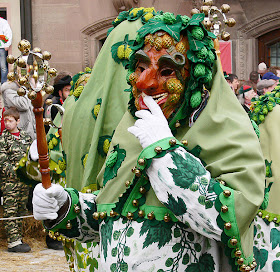Russian Carnival (See Original Image Here)
Carnival in European countries is celebrated just before the Lent and is more popular in the Catholic areas. It was originally a pre-Christian festival which marked the end of winters and beginning of spring. During this time, people wore masks and colourful costumes and danced in the streets. In ancient Rome, acrobats, dancers, actors, jugglers and tricksters also appeared in the streets to show off their skills. Gradually, the Catholic Church included it within its fold, removing the elements that didn't go with Christianity while retaining the celebratory aspect of the festival. It begn to be observed as a preparation for the fasting period of Lent, during which time rich food, meat and dairy products were forbidden. Hence, these foodstuffs had to be finished off before the beginning of Lent. Thus, carnival time was combined with great feasting and merry-making before the fasting period began. Different countries combined this with their own pre-Christian elements into the Carnival celebration. Because of this, carnival in every country acquired its own local flavour and has remained to be so.
Costume and Mask at Tettnang in Germany (See Link Here)
Costume and Mask from Ramstein, Germany
Swabia in Germany has a custom that at the end of winter they drive away the cold and lifelessness, believed in the ancient times to have been brought by the witches and spirits, by wearing witch-like masks and dancing in the streets. This element has been incorporated into the Swabian Carnival.
"Witch-Costume" from Swabian carnival
Protestants don't observe the carnival as they don't regard including the pre-Christian elements into their religious observances as appropriate. However, countries such as Denmark, Austria and Switzerland have their own variations on the Carnival.
As the Europeans established their colonies in Asia and South America, they also influenced these regions with their culture and the Carnival was brought to these regions. As a result, carnivals of South America, Kerala and Goa have their own flavour as they combine the European elements with their local elements and also borrow from other religions in their countries. One such instance is the painting of faces and throwing colours at each other during Goa Carnival, which is obviously an influence of the Hindu colour festival of Holi. In Brazil they like to wear their traditional tribal head-gear made of gorgeous feathers.
Following is a photographic project of carnival in Europe and Americas -
A Goa Carnival Parade at Panjim, the capital town of Goa -
See Original Video Here
Apart from the parades in towns of Panjim and Margao, Goa also has local village carnivals, where villagers like to show off their traditional village life alongwith masked dances and also their traditional Goan dances. In Goa, it's celebrated for four days before the Ash Wednesday. Following is one such video showing a South Goan village carnival.
Goa Village Carnival and Maypole Dance
Another European celebration that has emerged from the pre-Christian times is the Maypole dance. It was originally a fertility celebration. A long pole was decorated with garlands, stripes, flowers, flags etc. and the people danced around it. Later, the Church included it within its fold. Some puritanical Churches don't include it as they regard it as un-Christian. There is a second kind of Maypole dance which originated in Italy and France in the 18th century as a traditional art form, celebrated on May Day. From there it travelled to the theatre stages of London and became very popular. It involves wrapping stripes of colourful ribbons around a short pole. The loose ends are held by the children, who dance on music around the pole to unravel the ribbons.The video above shows one such dance.
The second form of Maypole dance reached India with the Missionaries, who set up schools in various parts of India. This dance was introduced in these schools. As a child, I remember having danced around a Maypole holding colourful ribbons and wearing a colourful dress. Unlike in the video above, we were taught dance steps and we moved around the pole dancing slowly to the music. After the ribbons were unravelled, we stood with these ribbons in our hands and danced with them.
In the countryside of England, the Maypole dance was celebrated by the young maidens, who danced around a pole holding strands of flowers strung together or simple ribbons of different colours wrapped around a pole. This was a pre-Christian tradition which endured for centuries befor getting absorbed in the early Church. It was observed in honour of Flora, the goddess of flowers. The younger girls formed the inner ring while the older girls formed the outer ring. See more on this dance here.
In the countryside of England, the Maypole dance was celebrated by the young maidens, who danced around a pole holding strands of flowers strung together or simple ribbons of different colours wrapped around a pole. This was a pre-Christian tradition which endured for centuries befor getting absorbed in the early Church. It was observed in honour of Flora, the goddess of flowers. The younger girls formed the inner ring while the older girls formed the outer ring. See more on this dance here.





